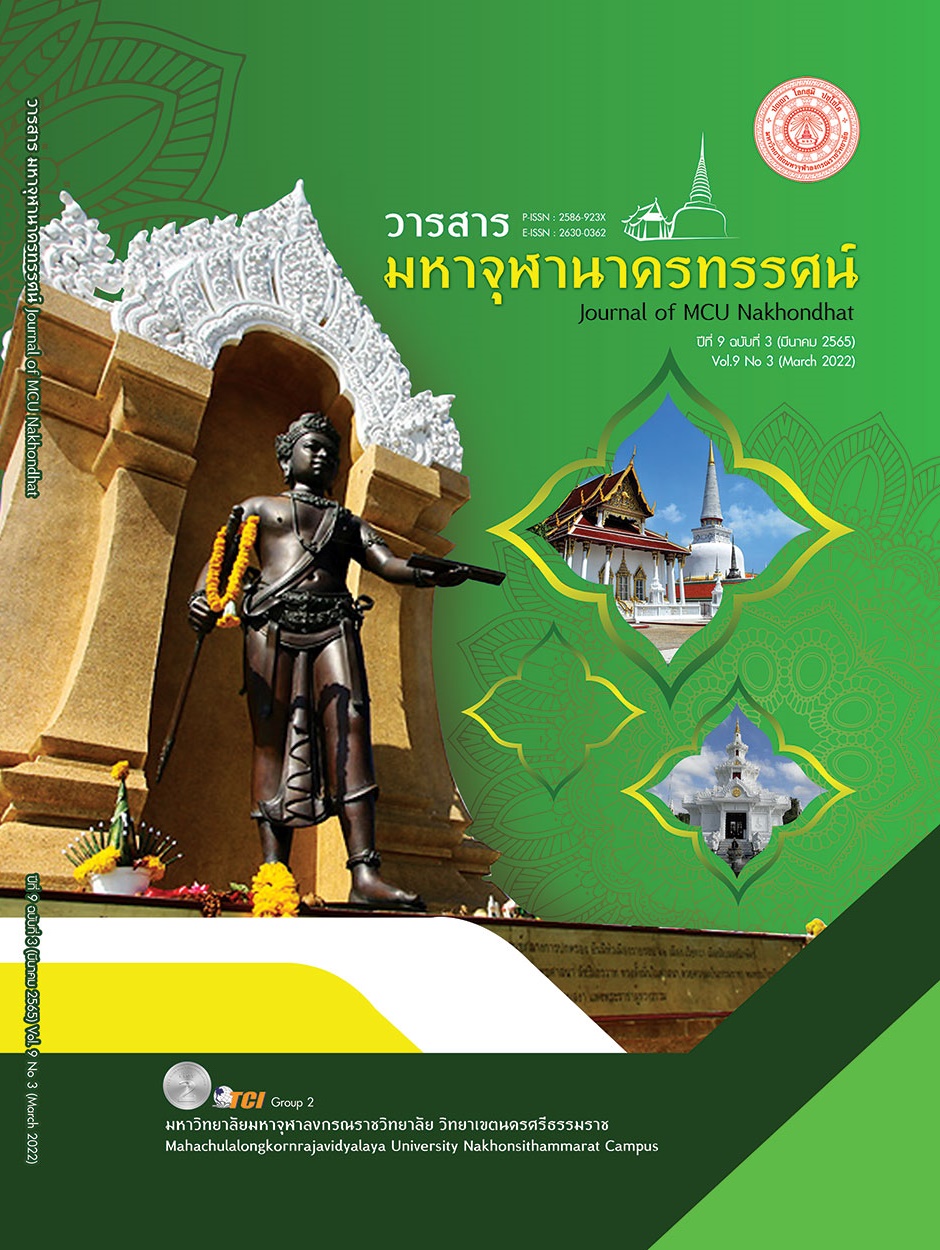THE FACTORS RELATED TO IMPLEMENTATION OF PREVENTION MEASURES FOR CORONAVIRUS DISEASE 2019 IN SOI SURAO COMMUNITY RATCHATHEWI DISTRICT BANGKOK METROPOLIS
Main Article Content
Abstract
The purpose of this research were to study the implementation of prevention measures for coronavirus disease 2019and the factors related to the implementation of prevention measures for coronavirus disease 2019 of the people in Soi Surao Community, Ratchathewi District, Bangkok Metropolis. Cross-sectional survey research was employed. The samples comprised 161 people representing households in Soi Surao Community, Ratchathewi District, Bangkok Metropolis. The questionnaires were used for data collection during 8th - 22nd November 2021. The data were then analyzed using frequency, percentage, mean, standard deviation, Chi – square analysis, and Pearson's Product Moment Correlation Coefficient statistics. The findings of the study showed the sample was female for 57.1%, Aged between 20-39, which was the same as 30-39 years old, accounting for 28.0%, with the lowest age being 20 years and the highest age 65 years. the implementation of prevention measures for coronavirus disease 2019 was indicated at a high level accounted for 64.6%, followed by a moderate level accounted for 35.4%, respectively, but a low level was not found. The statistically significant (p-value < 0.05) related factors to people’s implementation of prevention measures for coronavirus disease 2019 included age, education level, and knowledge on the prevention of coronavirus disease 2019.The results of this study suggested that public health officials in the community should communicate, understand, and campaign for the implementation of prevention measures for coronavirus disease 2019, especially knowledge on the prevention of coronavirus disease 2019 in older to encourage people to have knowledge and understanding of prevention and cooperation in complying disease prevention measures.
Article Details

This work is licensed under a Creative Commons Attribution-NonCommercial-NoDerivatives 4.0 International License.
References
จันทิมา ห้าวหาญ. (2563). ความรู้ความเข้าใจและพฤติกรรมการปฏิบัติตนเกี่ยวกับการป้องกันโรคโควิด-19 ของประชาชนในจังหวัดภูเก็ต. ใน วิทยานิพนธ์ ครุศาสตร์มหาบัณฑิต สาขาครุศาสตร์. มหาวิทยาลัยราชภัฏภูเก็ต.
จุฑาวรรณ ใจแสน. (2563). พฤติกรรมการป้องกันโรค COVID-19 ของพนักงานสถาบันวิจัยวิทยาศาสตร์สาธารณสุข กรมวิทยาศาสตร์การแพทย์. ใน วิทยานิพนธ์ คณะบริหารธุรกิจ สาขาวิชาการเงินและการธนาคาร. มหาวิทยาลัยรามคำแหง.
ณัฏฐวรรณ คำแสน. (2563). ความรู้ ทัศนคติและพฤติกรรมในการป้องกันตนเองจากการติดเชื้อไวรัสโควิด-19 ของประชาชนเขตอำเภออู่ทอง จังหวัดสุพรรณบุรี. วารสารวิทยาลัยพยาบาลพระจอมเกล้า, 4(1), 33-49.
ดรัญชนก พันธ์สุมา. (2563). ความรู้ ทัศนคติ และพฤติกรรมการป้องกันโควิด 19 ของประชาชนในตำบลปรุใหญ่ อำเภอเมือง จังหวัดนครราชสีมา. วิทยานิพนธ์ คณะสาธารณสุขศาสตรมหาบัณฑิต, มหาวิทยาลัยเทคโนโลยีสุรนารี.
ระวิ แก้วสุกใส. (2564). ความสัมพันธ์ระหว่างความรู้และการรับรู้กับพฤติกรรมการดำเนินชีวิตแบบวิถีใหม่เพื่อการป้องกันโรคติดเชื้อไวรัสโคโรนา 2019 (COVID-19) ของประชาชนจังหวัดนราธิวาส. วารสารเครือข่ายวิทยาลัยพยาบาลและการสาธารณสุขภาคใต้, 8(2), 67-79.
ศูนย์ปฏิบัติการด้านข่าวโรคติดเชื้อไวรัสโคโรนา2019. (2564). รายงานการติดเชื้อไวรัสโคโรนา2019. เรียกใช้เมื่อ 7 กรกฎาคม 2564 จาก https//www.moph.go.th.
สำนักงานเขตราชเทวี. (2564). ข้อมูลชุมชนฝ่ายทะเบียนสำนักงานเขตราชเทวี. เรียกใช้เมื่อ 7 กรกฎาคม 2564 จาก https://webportal.bangkok.go.th/ratchathewi
อภิวดี อินทเจริญ. (2564). ปัจจัยที่มีอิทธิพลต่อพฤติกรรมการป้องกันโรคติดเชื้อไวรัสโคโรนา2019 ของประชาชนในเขตเทศบาลเมืองคอหงส์ จังหวัดสงขลา. วารสารสภาการสาธารณสุขชุมชน, 3(2) :19-30.
Daniel,W.W. (2010). Biostatistics:afoundation for analysis in the health sciences. (9th ed.) New Jersey: John Wily&Sons.
Zhong, B. L., et al. (2020). Knowledge, attitudes, and practices towards COVID-19 among Chinese residents during the rapid rise period of the COVID-19 outbreak: A quick online cross-sectional survey. International Journal of Biological Sciences, 16(10), 1745–1752.


